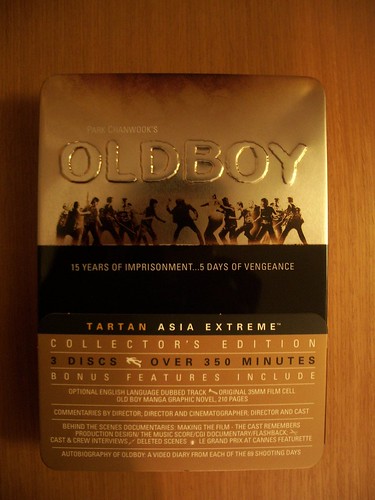by Chi-Yun Shin
Jump Cut #50


"Asia Extreme" is the first distribution label created to specifically deal with East Asian film titles by Tartan Films, which operated as Metro-Tartan Distribution between 1992 and 2003, before reverting back to the name Tartan Films.[1][open endnotes in new window] Launched in 2001 as the first of its kind, Tartan Asia Extreme has successfully released a number of titles which, to name just a few, include
Japanese films such as Ring/Ringu (1998), Audition (1999), and Battle Royale (2000);
South Korean films – The Isle (2000), Old Boy (2003) and A Tale of Two Sisters (2003);
Hong Kong films from Hard-Boiled (1992) to the Infernal Affairs series (2002-4)
as well as the films from Thailand – Bangkok Dangerous (1999), The Eye (2002).
Now with an extensive and ever growing DVD catalogue, which includes the pan-Asian horror omnibus films, Three … Extremes (2004) and Three Extremes 2, Tartan Asia Extreme has emerged as the most high-profile label amongst the East Asian film providers, playing an instrumental role in promoting and disseminating East Asian films in the West in recent years. It has also launched an U.S. distribution of many of the same titles, although a significant number of the best-known titles are distributed by other firms in North America.
Hamish McAlpine, who is the founder and owner of Tartan Films, is in fact responsible for the creation of the Asia Extreme label. The story goes that one weekend at the end of 1999, McAlpine watched two Japanese films on video, and he was “totally blown away by them.” The two films he watched back to back that weekend were Hideo Nakata’s Ringu and Takashi Miike’s Audition. Soon after, he came across Thai and South Korean titles – Bangkok Dangerous and Nowhere to Hide (Lee Myung-Se, 1999), which were also “outrageously shocking” to him. In an interview, McAlpine emphasised the fact that the films came first:
“When I realised that these films were not one-offs and there was a constant flow of brilliant films coming out of Asia, I decided to brand it and make Asia Extreme.”[2]
And, that’s how the label was born. Since then, as the Tartan Asia Extreme website boasts,
“Asia Extreme has been single-handedly responsible for the groundswell of interest in Asian cinema and the widespread attention that its roster of World class directors, such as Hideo Nakata, Miike Takashi, Kim Ki-duk and Park Chan-wook, have enjoyed.”[3]
It is important to note here that region-free or multi-region DVD players and the proliferation of international mail-order websites (Internet DVD shops) since the end of the 1990s had enabled Asian film fans to purchase titles from abroad.[4] What the Tartan Asia Extreme has achieved, however, is successfully infiltrating into the minds of mainstream audience and shelves of high street shops (such as HMV in Britain) as well as Internet shopping sites such as Amazon and Play.com.
Starting off as a cult phenomenon, targeting the cult "fan-boys" but soon incorporating the art-house audiences (or world cinema patrons) to its niche, the Tartan Asia Extreme label has established itself as an immediately recognisable brand.[5] Subsequently, as McAlpine himself described, with the Asia Extreme label, Tartan
“found the pot of gold at the end of the rainbow [by identifying] ‘the next big thing’ ahead of your competitors and becoming the early dominant provider.”[6]
Recent high profile Hollywood remakes of such East Asian titles as Ringu, Ju-on: The Grudge (Takashi Shimuzu, 2002), Dark Water (Hideo Nakata, 2002) and Infernal Affairs (the remake of which was directed by Martin Scorsese and re-titled as Departed, the film winning the best film award at the 2007 Oscar), as well as Quentin Tarantino’s reported support and endorsement of OldBoy at the 2004 Cannes Film festival (where the film won the second prize, Grand Prix du Jury), only raised the interest in, and the profile of, East Asian cinema and the size of "the pot of gold" McAlpine had discovered.
Indeed, it is commendable that Tartan Asia Extreme has carved a viable East Asian film niche, at the same time establishing its name in the industry where distribution labels do not normally make much impact in the market place. Questions, however, are raised as to the reductive nature of Tartan’s marketing practices, which repackages the films “as exotic and dangerous cinematic thrills.”[7] In addition, the output of the label, and indeed the name of the label itself, invoke and in part rely on the western audiences’ perception of the East as weird and wonderful, sublime and grotesque. At the same time, the ways in which Tartan registers and navigates the vagaries of distinct national cultures and different genres gathered under the Asia Extreme banner provide a fascinating site to explore how the West consumes East Asian cinema.
In order to illustrate how the so-called Asia Extreme films are presented, this article will examine Tartan’s marketing strategies for the Asia Extreme brand, especially its horror titles, not only because they have become the most prominent and leading examples of the label, but also because the rise of Asia Extreme coincided with the phenomenal success of "Asian horror" with branches such as "J-Horror" and "K-Horror," which have been celebrated as the most original and innovative horror movies of the last decade. (The notion of horror or what constitutes horror, however, is not the main concern here, but horror films here broadly refer to films that evoke fright, terror and abjection from viewers.) Needless to say, different audiences understand films in different ways, but as Mark Jancovich pointed out,
“Advertising campaigns were designed in part to present a range of possible ways of reading films.”[8]
The article will also engage with the critical reception of the most "notorious" Asia Extreme titles – Audition, The Isle and Oldboy — in the U.K. and the U.S. so as to understand the different discourses through which the Asia Extreme films are evaluated and mediated.
To Read the Rest of the Essay



No comments:
Post a Comment